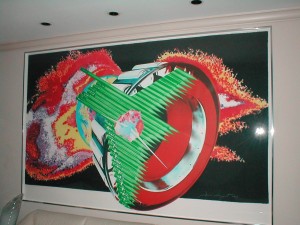Pinky Says: A TRIBUTE TO JAMES ROSENQUIST
It was a really hot day in New York, so hot that our art tour group was already irritable and hoping that somewhere along the line of artists’ studios we were visiting there would be an air conditioned respite. When we stood outside James Rosenquist’s studio we had already been to 3 other places, none of which seemed promising for cool air. Rosenquist opened the door and was startled to see 24 people. One of the jokesters in our group explained that we were the mothers’ march against polio. Rosenquist’s confusion disappeared immediately. He opened the door and greeted us as if we were long lost relatives. This eager bunch of art lovers fell for him hook, line and sinker.
James Rosenquist grew up in a house that had no electricity. He was 14 when he won a scholarship to study art four days at the Minneapolis School of Art. He recognized that he was involved in “serious business” because he was given an eraser that cost 25 cents and sheets of paper that cost 35 cents each. There were no books on art available to him; he was much more familiar with illustrations from adventure and girlie magazines. There was no room in his mind for abstraction in art. He painted things as real as he could. As an adult he painted billboards of Hollywood stars with faces 20 feet high, noses 10 feet tall and eyes 3 feet wide. As a member of Local 230, the sign painting union, he painted Kirk Douglas as a Viking and Elizabeth Taylor in a swimsuit while working on a scaffold 22 stories above Times Square. He also painted signs for Seagram’s Canadian Club and Hebrew National Salami. He would make the salami look mouthwatering. Everything he painted was real. He was a brilliant sign painter and everybody liked him. Today he has been everywhere, knows just about everybody. He has had shows at the Guggenheim and the Whitney and countless major museums around the world. A painting of his appears on the cover of a telephone book in Dubai. And still everybody likes him but they also thrill to his work.
It is the work that Rosenquist does that celebrates him most of all. He has painted soups, salads, spaghetti, beer, movie stars, groceries, cars, airplanes, and space. His own observations of his work are fascinating. “I really work hard to create some kind of meaning out of the things I use…..They suggest meanings but they resist drawing conclusions…..The work has an intrinsic meaning for me, but remains open to multiple interpretations. I want to encourage the possibility of exploring meanings beyond those I put there……I count on the viewer bringing something to the work.” And this is really the purpose of a great painting –it is necessary for the viewer to be a part of the exploration and the understanding of the work.
Rosenquist has never been fond of the term Pop Art, but over 50 years of being described as a pop artist he is resigned to it. He says that he is still unsure of what the term means. “What united us (Warhol, Lichtenstein, Oldenburg, Wesselman) was dread of the drip, the splash, the schmear,” combined with an ironic attitude toward the banalities of American consumer culture. It was born out of rejection of abstraction and its anarchic angers. But it was also a comment on the boring middle class acceptance of mediocrity. By depicting the household appliances and the movie stars and the foods Rosenquist was understanding the daily needs of Americans as well as revealing their dependence on the trite everyday household they lived in. It was then the work of the viewer to add their own meanings to the art, to be a part of the exploration of the work of art. To viewers who say that his imagery is enigmatic, Rosenquist replies that there is a story behind the pictures. “Nothing is arbitrary in my paintings. If you ask me why there are tubes of lipstick there or why is that dog climbing the stairs I can tell you exactly what got me off the chair to paint it.”
Rosenquist has had his ups and downs in life as have most painters. There were long periods when he could not sell anything. He suffered a terrible automobile accident. A forest fire destroyed his house, office, studio and 62 acres of magnificent vegetation. Today he lives in New York; and Florida and he has befriended ordinary people whom he understands and respects. “People ask me why I paint. I don’t know why except that when I don’t paint I get cranky. Maybe I paint to prove to myself that I had an idea.” It is his decency and his downright niceness, his wonderful sense of humor and his honesty that endears him to all who meet him. He feels strongly about civil rights and moral issues. His paintings protest against “stupid wars, stupid laws, ruthless politicians and greedy entrepreneurs.”
Rosenquist is a remarkable man in that fame has not dimmed his greatness as an artist. And he still abides by his honest definition of his art, “All art is about feeling. Critics may talk about cool abstractionists and hot expressionists, but hot or cold, abstract or representational, it’s all about eliciting emotion, otherwise we wouldn’t do it.” We would have to journey far to get a better picture of Rosenquist’s art and the artist himself.



Leave a Reply